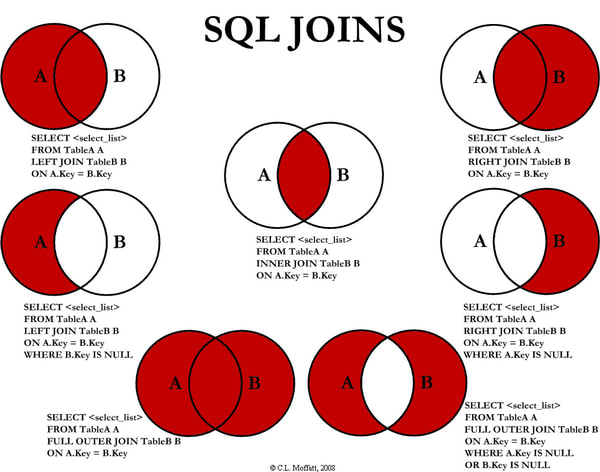Now that we’re finally a third of the way through this series, things are finally starting to come together. Sure, we know about quite a few different data structures, how they work, which ones are fast, and how certain ones are more helpful for solving specific problems than others.
But there’s almost no point to knowing any of that if we don’t have a sense of how they’re actually used in real life. It’s like learning geometry: it probably all seemed pointless until one day, you woke up and realized that you were actually going to have to calculate the square footage of a room because you wanted to re-carpet the floor! (Okay, I’ve never actually had to do that, but I can imagine that geometry as a concept would generally be pretty helpful if I ever have to.)
A lot of things are going to come together today, because we’re going to learn about a data structure that is almost dogmatic in its theory, but incredibly ubiquitous in practice. In fact, you’ve probably already worked with this structure in some shape or form, and you were likely introduced to it in your middle school math class.
So, what data structure am I talking about? Why, I’m referring to the all-powerful set , of course!
No fear set theory
Before we get into the actual implementation of sets, we first need to understand where on earth they come from. This means it’s time for us to dive into theory – set theory! But, fear not: there’s a good chance you’ve used set theory in some capacity or another. In fact, you probably know set theory by another name: a Venn diagram. The Venn diagram was actually only incorporated into the “set theory curriculum in the 1960’s because it was such an effective way of illustrating simple relationships between sets.
Okay, now that we’re sure that set theory won’t be that scary, we’d better figure out what it is, exactly! A set is actually a mathematical concept, and the way that we relate sets to one another is referred to as set theory.
A set is nothing more than an unordered collection of elements with absolutely no duplicates.
There are three important pieces to that definition: unordered , elements , and no duplicates. Actually, those three words encompass pretty much the entire definition of a set; if we can remember that, we’ll basically know everything about how sets work.
But we’ll come back to why that’s important in a bit. First, let’s look at some sets in action. We know that sets are well-represented by Venn diagrams, so for our example, we’ll look at two sets: a set of some of the books I’ve read, and a set of some of the books I own.

Since we’re familiar with the concept of Venn diagrams, we know that the center section in green (where the two sets intersect) represents books that I have both read and books that I own. We also know that the two sets drawn above exist within the larger group of all the books in the world!
The Venn diagram is a good introduction to set theory, because it makes the next part a lot easier to explain. Imagine that we wanted to represent these two sets of data in some sort of structure. Well, we already know that we need to divide them into two groups: books I’ve read, and books I own. To make it a little easier, we’ll call books I’ve read as set X , and books I own as set Y. Reconfigured into data structures, those two sets in the Venn diagram could also be rewritten to look like this:

We’ll notice that both set X and set Y look a little bit like objects or hashes: the elements don’t have indexes or any sort of order. They also don’t have any repeated values, which is part of what makes them a set. Remember that a set is a collection of unique, unordered objects, which means that we’ll never find duplicated values within a set.
Pain-free (set) operations
So, what can we do with these sets now that we have them written in data structure format? Well, we can perform some operations on them! The two most important operations that are performed on sets are intersections and unions.
The intersection of two sets is often denoted in shorthand like this: X ∩ Y. The intersection represents where two sets – you guessed it – intersect! In other words, it yields all of the elements that exist within both of the sets. In our example, the intersection of set X and set Y are all of the elements that exist in both of them. A good way keyword to remember how intersections work is the word and : the elements that exists in both X and Y. In this case, that would mean “Code Complete and “Milk & Honey”. Even though they exist in both sets, since sets can only ever contain unique values, we don’t repeat them; each of these book titles exists only once in the set.
The union of two sets is often denoted in shorthand like this: X ∪ Y. The union represents the entirety of two sets, or the two sets when they’ve been united together. In other words, it yields all of the elements that exist in either of the two sets. A good way keyword to remember how intersections work is the word or : the elements that exists in both X or Y. In this case, that would mean all of the eight book titles! The important thing to remember is that even though “Code Complete and “Milk & Honey exist in both sets, they can only ever appear once in the union of set X and set Y, since sets can only have distinct values and can never contain duplicates.
If we were to apply intersections and unions to our Venn diagram from earlier, our diagrams would look like this:
Okay, time to complicate things a little bit more! Intersections and unions are great, but they’re only scratching the surface of set theory. For our purposes, we’ll need to be familiar with some other operations as well. As it turns out, there are two operations that turn up quite a bit in computer science: set differences and relative complements. We’ll learn how they both play a role in the next section, but first, let’s figure out how they work!

Set differences are how we can figure out the difference between two sets. In other words, we can determine what a set looks like without any of the elements that are contained in the other set. Another way to write this is X – Y. In the example shown here, the difference between set X and set Y results in all of the elements that exist in set X but do not exist in set Y, or the letters C, Z, and W.
Relative complements are basically the opposite of set differences. For example, the relative complement of Y as compared to X will return all of the elements in set Y that don’t appear in set X. We can denote the relative complement by using the short hand Y ∖ X , which is actually results in the exact same returned set as Y– X. In our example, the set Y is smaller than the set X. In our example, the only thing that exists in Y that doesn’t exist in X is the number_ 2_.
Effectively, we’re simply subtracting set X from set Y, and answering the question: what exists in Y that doesn’t exist in X?
You might have noticed that in some of the examples, we’re dealing with strings, and in others, the elements are letters, and sometimes even numbers. This brings up an important point: sets can contain literally any kind of element or object! You can think of them as hashes in that way: they can hold any item, as long as it only occurs once within the set.
Alright, let’s look at one last operation – the most complicated one of them all. But we can handle it!
Sometimes, when we have two sets, we might want to find the opposite of the intersection of the two sets. In other words, I might want to find all of the books that I own, and all of the books that I have read, but none that intersect between the two. What would we call that subset? And how would we find it?
Well, the proper term for what we’re looking for in this case is something called the symmetric difference of our two sets, which is also sometimes referred to as the disjunctive union. The symmetric difference yields all of the elements that exist within either of the two sets, but do not exist at the intersection (X ∩ Y) of them.
Let’s look at an example, which should help clarify what I mean:

In the example above, the symmetric difference is basically the same as find the relative complement of set X and set Y. If we super mathematical about it, finding the symmetric difference is the same as finding the union of relative complements of set X and of set Y. We could write that out as: X △ Y= (X ∖ Y) ∪ (Y ∖ X).
But don’t let that confuse you!
All we really need to do in order to find the symmetric difference of two sets is ask ourselves: what elements exist in set X that don’t exist in set Y, and which elements exist in Y that don’t exist in X? In other words: which elements are unique to each set, and don’t occur within both of them?
In the example above, the numbers 1, 2, and 3 occur within both sets. However, the letters A, B, C and X, Y, Z occur only within set X or set Y, and are therefore the symmetric difference of the two sets.
Okay, that was a lot of theoretical stuff. Let’s see this theory play out in practice, shall we?
Sets all around us
Hopefully by now, you’re wondering what the point of learning sets is. I don’t blame you: it’s a good question! And it’s finally time to answer it.
Guess what? Sets are everywhere. They’re actual data structures that we can use whenever we want in Java, Python, Ruby, and even JavaScript! You might even be able to guess some of the methods that each of these languages allows us to perform on sets.
Let’s take a quick look, using JavaScript as an example:
var s = new Set();
s.add(2);
// Set { 2}
s.add(45);
// Set { 2, 45}
s.add(45);
// Set { 2, 45}
s.add('hello world!');
// Set { 2, 45, 'hello world!' }
s.has(2);
// true
s.has('cats');
// false
s.size;
// 3
s.delete(45);
// Set { 2, 'hello world!' }
s.has(45);
// false
Obviously, some of the method names will change from language to language. For example, Ruby’s implementation of has is called include?, but the idea is fairly similar from one language to another. Python’s version of sets actually allows you to call methods like intersection, union, and symmetric_difference!
But, what good are sets, anyways? I mean, we can use them in all of these languages, but when are they useful?

Well, for one thing, they can be pretty time-efficient.
Remember all of those complicated operations like intersection, union, and difference? Well, guess what? The amount of time it takes for us to run any of those complex operations depends purely on the length of the two sets. This is because in order for us to find the intersection, union, or difference/complement of these two sets, we have to effectively traverse through the entire length of the two sets being compared. Usually, even giant sets still won’t take that much time to traverse.
But what about basic operations? What about adding an element to one of those sets, removing it, or even finding an element within it? Well, all of those operations take constant time , or O(1). This can be incredibly powerful, and often means that a set might be a better structure than a dictionary or a hash!
But, wait a second: how is it possible that all of these set operations are so fast?! How does that even happen? Well, as it turns out, many sets are actually implemented by hash tables under the hood! (See, I promised you it was all going to come together!) We already know about hash tables, but why do they make for good skeletons for set implementations?

Well, there are a few good reasons: first , given what we know about hash tables, they’ll always have unique keys for each element. This is great for sets, since sets can only have unique values in them. Second , in hash tables, order doesn’t really matter, just as how order doesn’t matter in a set. Finally , hash tables provide a O(1) constant access time, which is what ideal for basic operations performed on a set.
Alright, so hash tables make for good sets. And sets are data structures that most languages give us for free. But when I started this post, I told you that sets were everywhere, right? I feel like I should probably let you in on a little secret that’s going to (hopefully) blow your mind:
Relational databases are based almost entirely upon set theory.
In fact, if you’ve ever worked with or queried a database, or had to write SQL, you’re probably familiar with the idea of finding records at the intersection of a table.

This is nothing more than an abstraction of the Venn diagram version of sets that we started off this post with! In fact, even the most complicated SQL statements are nothing more than operations on sets.

A SQL INNER JOIN is just the intersection of two sets.
Finding the LEFT JOIN of two tables is nothing more than finding the set difference or the relative complement of the two tables.
A SQL query that calls for a FULL OUTER JOIN is merely returning the union of two sets.
And that super complicated FULL OUTER JOIN where one keys on both tables is NULL? (Also known as the bane of my existence when it comes to writing SQL statements?) That’s just the symmetric difference or disjunctive union of two tables.
How amazing is that?! All of that seemingly boring set theory, when put into practice, makes databases seem like the coolest things ever. And that, my friend, is a truly a feat in and of itself!
Resources
Set theory is fairly widespread in various parts of computer science, from its use in relational databases, to a data structure that exists in various languages, including Python, Ruby, JavaScript, and Java. There are plenty of good resources out there to help you get a better understanding of set theory; here are a few to get you started!
- LEFT JOIN vs. LEFT OUTER JOIN in SQL Server, StackOverflow
- Set Theory, MariaDB
- Complexity of Python Operations, Professor Richard E. Pattis
- Set Theory – Design of Computer Programs, Udacity
- Set Theory | Introduction, GeeksforGeeks
This post was originally published on medium.com








Top comments (13)
Very useful, thank you.
Of all the ways you could've presented a correction, you chose the one that was the least constructive and was most self-serving. Instead of "it might be helpful to think of it in terms of X", you opened with three of the most tactless sentences you could've used which, as the site admin responded on another comment on this very post, is not okay in this community, and then continued by posting links to your own comments on StackOverflow.
In fact, it appears that you made accounts on both Medium and dev.to specifically to try to dispute Vaidehi's post with links to your own remarks; when I click your profile on both sites, this comment is all I see. Not only that, posting the same comment in both places is not helpful in any way. She'll see it if you only post it once. Instead, it's more evidence that you're just showing off how smart you think you are. Rather than trying to suggest to the author to take a second look at something (because, again, she'll see it if you just post it once), you're posting it so readers will acknowledge you.
With that out of the way, SQL is indeed based on set theory. Relational algebra itself is based heavily on set theory. The "logic" you mention is a broad topic and you really could've narrowed that down a bit. Boolean logic does indeed determine matching criteria for the result set, but that's only part of a SQL statement.
In summary, Vaidehi's right. She may not have presented it in the way you wanted, but she also didn't deserve your response.
Its really awesome to see you admins actively cracking down on the "elitism" mentality.
Thanks for your active work, hopefully the rest of lurkers like me can finally feel safe posting more here!
That is 1000% our intention! Jamie is not an admin, just a great part of our community, but admins/mods were responsible for the removal of the comment once it was made. Encouraging all the behavior of constructive activity on the site is everything we are about and we strive to have a moderation process that achieves this while also being fair and consistent. It's a constant effort to get better at it.
Thanks for the article! A very nice and clear refresher.
Some comments may only be visible to logged-in visitors. Sign in to view all comments.